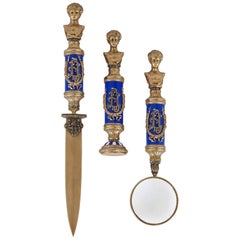Magnifying Glass Faberge
Recent Sales
20th Century Russian Belle Époque Desk Sets
Silver, Enamel
Finding the Right Desk-accessories for You
Whether you’ve carved out a space for a nifty home office or you prefer the morning commute, why not dress up your desk with antique and vintage desk accessories? To best tiptoe the line between desk efficiency and desk enjoyment, we suggest adding a touch of the past to your modern-day space.
Desks are a funny thing. Their basic premise has remained the same for quite literally centuries: a flat surface, oftentimes a drawer, and potentially a shelf or two. However, the contents that lay upon the desk? Well, the evolution has been drastic to say the least.
Thank the Victorians for the initial popularity of the paperweight. The Industrial Revolution offered the novel concept of leisure-time to Europeans, giving them more time to take part in the then crucial activity of letter writing. Decorative glass paperweight designs were all the rage, and during the mid-19th-century some of the most popular makers included the French companies of Baccarat, St. Louis and Clichy.
As paper was exceedingly expensive in the early to mid-19th-century, every effort was made to utilize a full sheet of it. Paper knives, which gave way to the modern letter opener, were helpful for cutting paper down to an appropriate size.
Books — those bound volumes of paper, you may recall — used to be common occurrences on desks of yore and where there were books there needed to be bookends. As a luxury item, bookend designs have run the gamut from incorporating ultra-luxurious materials (think marble and Murano glass) to being whimsical desk accompaniments (animal figurines were highly popular choices).
Though the inkwell’s extinction was ushered in by the advent of the ballpoint pen (itself quasi-obsolete at this point), there is still significant charm to be had from placing one of these bauble-like objets in a central spot on one’s desk. You may be surprised to discover the mood-boosting powers an antique — and purposefully empty — inkwell can provide.
The clamor for desk clocks arose as the Industrial Revolution transitioned labor from outdoors to indoors, and allowed for the mass-production of clock parts in factories. Naturally, elaborate designs soon followed and clocks could be found made by artisans and luxury houses like Cartier.
Find antique and vintage desk accessories today on 1stDibs.
- 1stDibs ExpertOctober 12, 2021The best magnifying glass should be lightweight, have a large diameter, provide a wide viewing area, and offer high, distortion-free magnification. However, finding one unit that offers all of these attributes is almost impossible. Shop a range of antique and vintage magnifying glasses on 1stDibs.
- 1stDibs ExpertApril 5, 2022A magnifying glass can also be called a loupe. The loupe is a small magnifying device that helps the user see small details. You’ll find a variety of magnifying glasses or loupes from some of the world’s top sellers on 1stDibs.
- 1stDibs ExpertApril 5, 2022For coin collectors, a magnifying glass range of 10X to 30X is standard. At this range, you can easily examine mint markings and imperfections as well as grade coins. It’s important to purchase from a vetted seller or vendor to ensure authenticity when collecting coins. 1stDibs partners with only top-vetted sellers to offer authentic pieces that come with a buyer protection guarantee.
- 1stDibs ExpertApril 5, 2022The use of magnifying glasses is linked as far back as the ancient Egyptians. In Egypt, they used crystals or other shiny stones to view small objects better. However, the first magnifying glass crafted for scientific purposes is believed to be designed by Roger Bacon, an English philosopher during the 13th century. Browse a wide selection of vintage magnifying glasses on 1stDibs.
